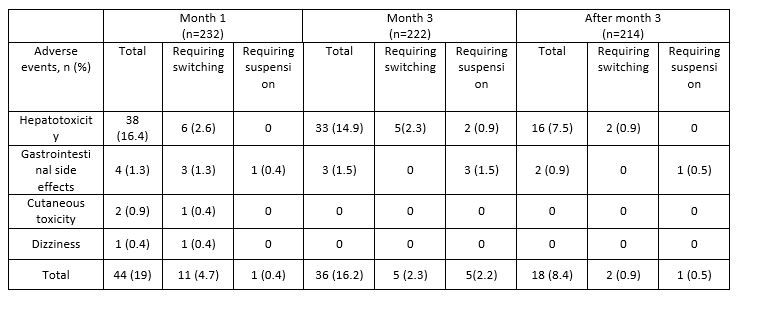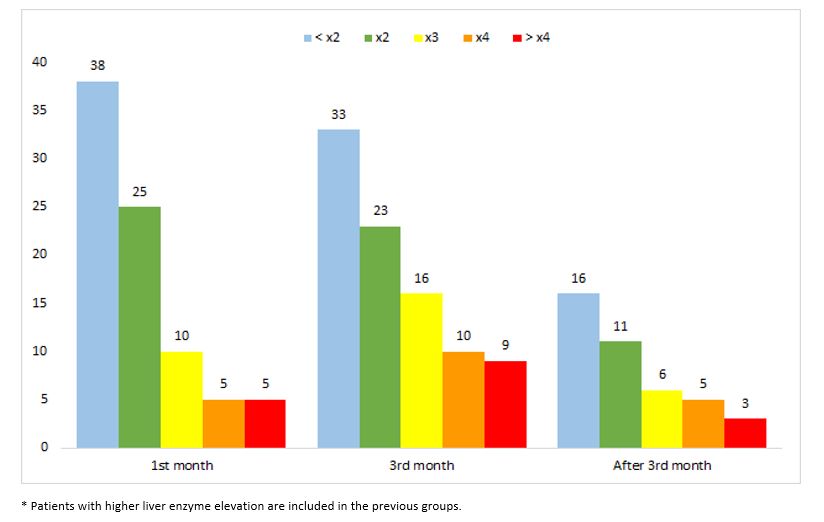Session Information
Date: Saturday, November 6, 2021
Title: Miscellaneous Rheumatic & Inflammatory Diseases Poster I (0183–0209)
Session Type: Poster Session A
Session Time: 8:30AM-10:30AM
Background/Purpose: Tuberculosis (TB) may be increased with biologic therapy (BT). Diagnosis and treatment of latent TB infection (LTBI) is the best strategy to prevent TB. In Rheumatic Immune-Mediated Diseases (R-IMID) and LTBI, chemoprophylaxis must be used before BT. The drugs more frequently used are Isoniazid (INH), Rifampicin (RIF) and Fluoroquinolones (FQ). These drugs may be associated with side-effects, especially hepatotoxicity.
Our aim was to assess, in a single University Hospital, a) used chemoprophylactic drugs and, b) adverse events with these drugs.
Methods: We included all consecutive patients in the last five years (2016-2020) with a diagnosis of R-IMID and a positive LTBI test (positive tuberculin skin test and/or interferon-γ–release assay), who received chemoprophylaxis prior to BT.
Dose of chemoprophylactic drugs were a) INH (5 mg/kg/d, maximum, 300 mg; for 9 months with vitamin B6), b) RIF (10 mg/kg/d, maximum, 600 mg for 4 months) and c) FQ levofloxacin (500 mg/day for 9 months).
In all patients analytic controls that included liver enzymes were performed at the 1st and 3rd month and then at a variable time.
Results: 240 patients were analyzed (165 women/ 75 men), mean age of 56±11 years. The underlying R-IMID of patients receiving chemoprophylaxis were rheumatoid arthritis (n=74, 30.8%), axial spondyloarthritis (n=59, 24.6%), psoriatic arthritis (n=62, 25.8%), conectivopathies (n=17, 7.1%), vasculitis (n=12, 5%), sarcoidosis (n=2, 0.8%), Behçet’s disease (n=1, 0.4%), inflammatory myopathies (n=1, 0.4%) and other (n=12, 5%).
At the onset of chemoprophylaxis they were taking: Prednisone in 61 patients (24 of them above 10 mg/day) and the following conventional DMARD, methotrexate (n=109, 45.4%), hydroxychloroquine (n=20, 8.3%), sulfasalazine (n=11, 4.6%), leflunomide (n=4, 1.7%) and azathioprine (n=2, 0.8%).
The first-line chemoprophylactic drug was INH in 232 (96.7%) patients and RIF in the remaining 8 (3.3%). Due to adverse events, second-line therapy was used in 18 (RIF, n=17 and Levofloxacin , n=1) patients previously treated with INH.
Adverse events were more frequent with INH, being observed in 55 patients (23.7%) out of 232. (TABLE, FIGURE). By contrast, only 1 out of 25 (4%) receiving RIF presented an adverse event, which was hepatotoxicity, requiring suspension of RIF. No adverse events were described in the only patient receiving levofloxacin.
Conclusion: INH is the most used first-line treatment for LTBI. RIF was mainly used as second-line therapy if an adverse event with INH was observed. Treatment was generally well tolerated and most adverse events did not require the withdrawal of the treatment. Hepatotoxicity was the most frequent adverse event with INH and the most frequent cause of treatment withdrawal.
To cite this abstract in AMA style:
Martinez-Lopez D, Rueda-Gotor J, Osorio-Chávez J, Álvarez-Reguera C, Portilla V, gonzalez-Gay M, Blanco R. Chemoprophylaxis in Latent Tuberculosis Associated with Rheumatic Immune-mediated Diseases. Study of 240 Patients from a Single University Hospital [abstract]. Arthritis Rheumatol. 2021; 73 (suppl 9). https://acrabstracts.org/abstract/chemoprophylaxis-in-latent-tuberculosis-associated-with-rheumatic-immune-mediated-diseases-study-of-240-patients-from-a-single-university-hospital/. Accessed .« Back to ACR Convergence 2021
ACR Meeting Abstracts - https://acrabstracts.org/abstract/chemoprophylaxis-in-latent-tuberculosis-associated-with-rheumatic-immune-mediated-diseases-study-of-240-patients-from-a-single-university-hospital/


